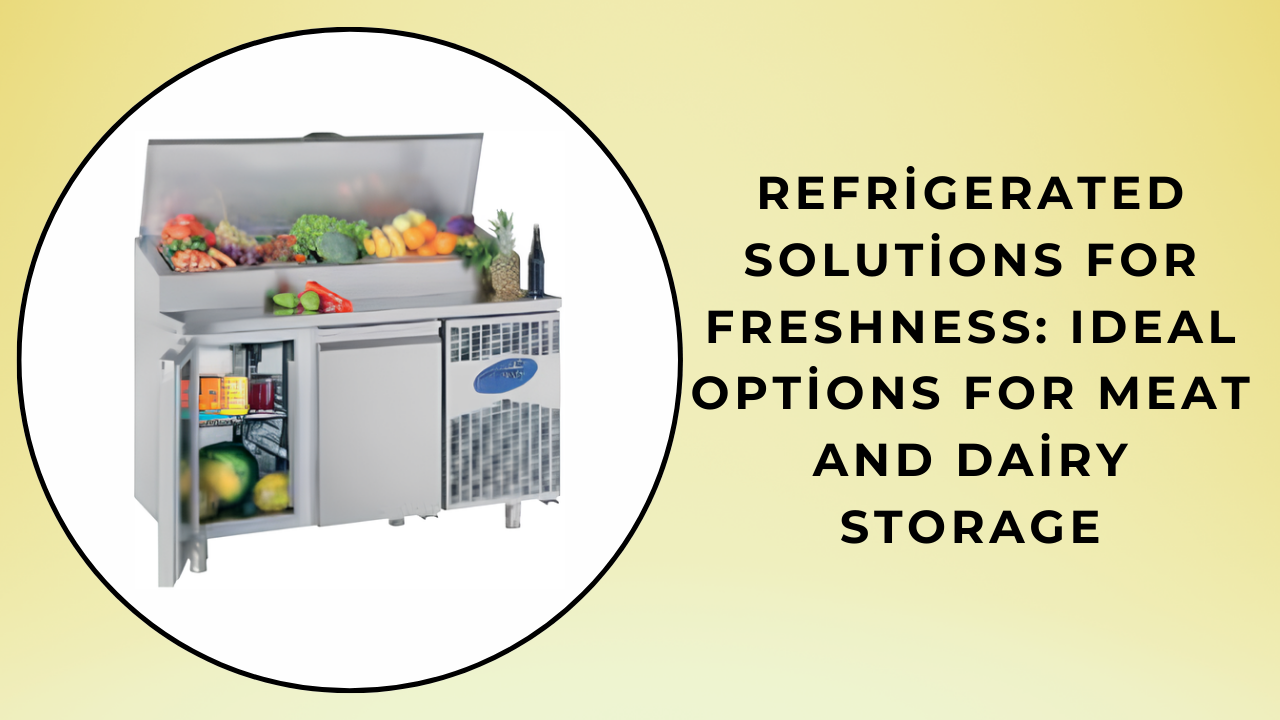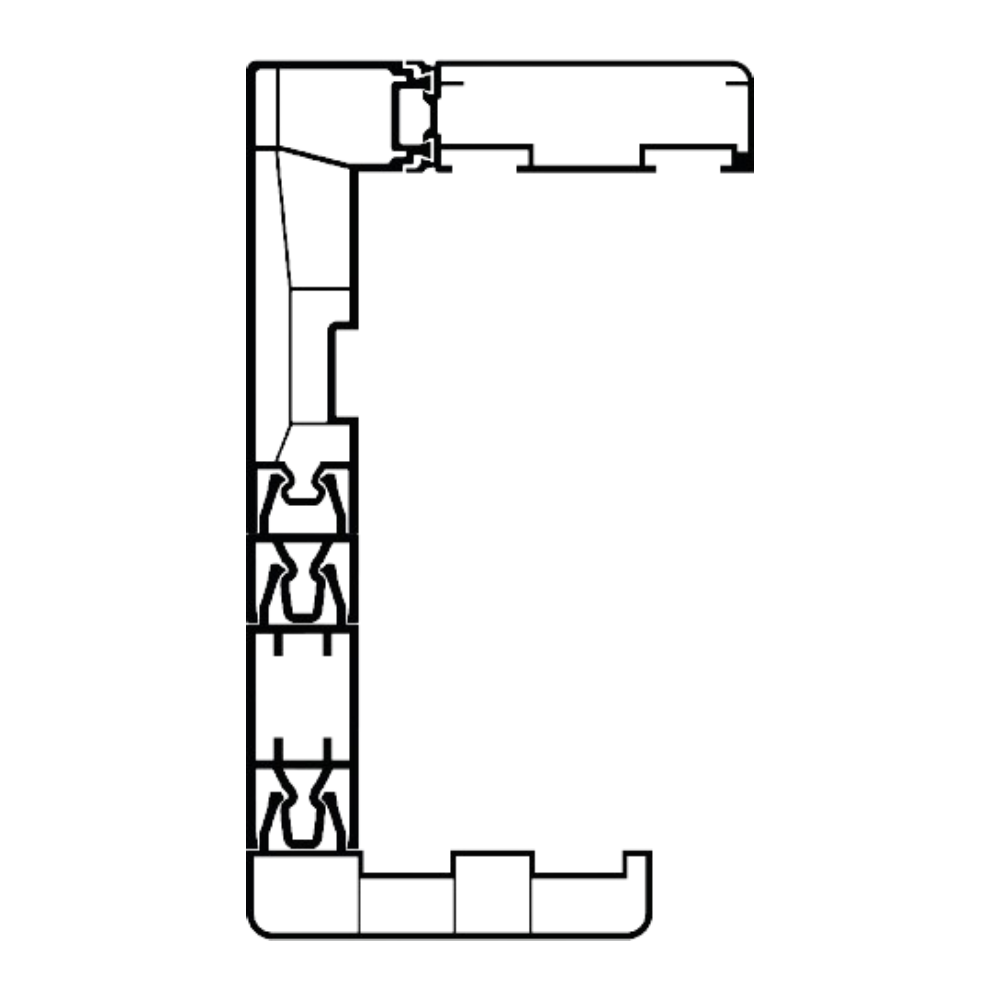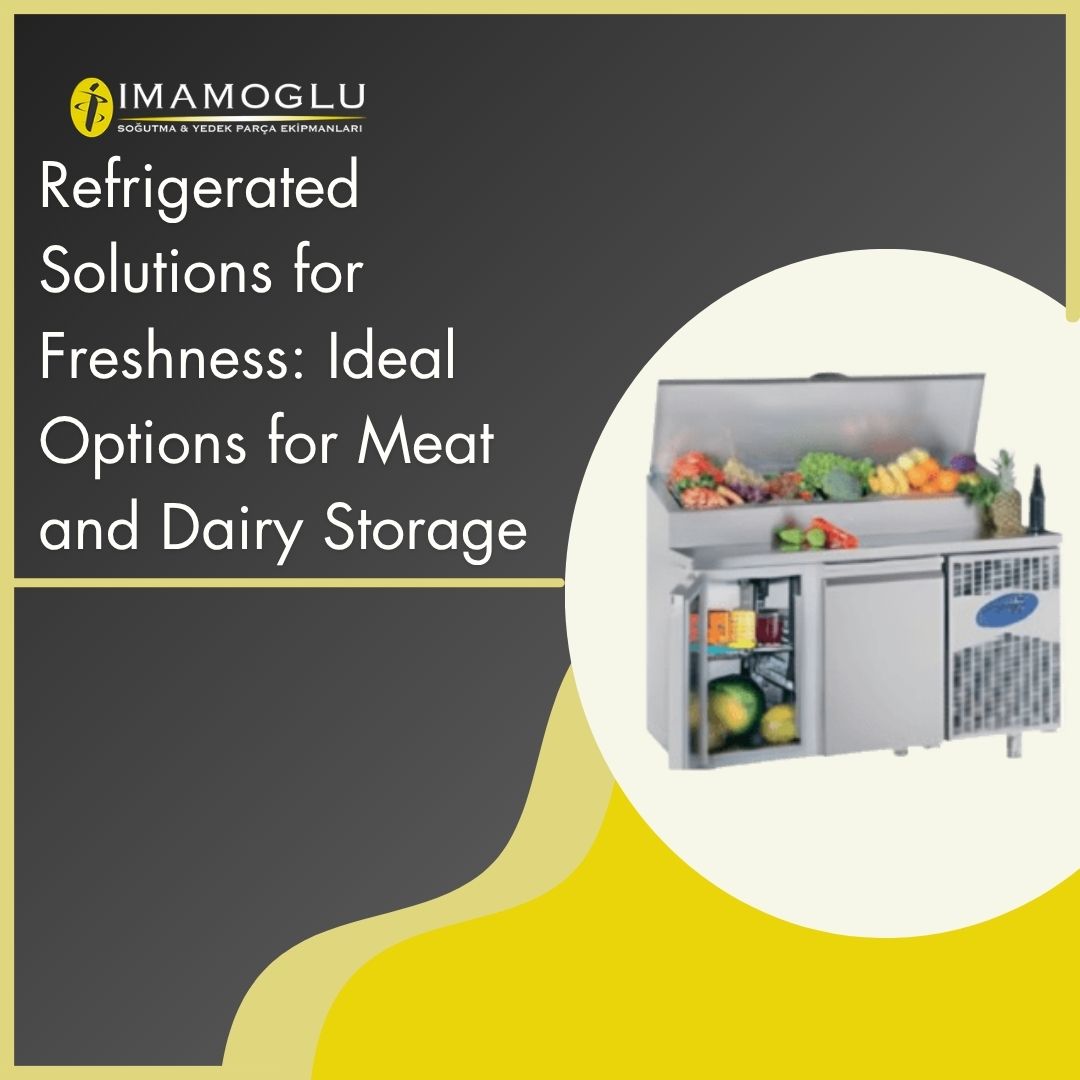Refrigerated Solutions for Freshness: Ideal Options for Meat and Dairy Storage
What are refrigerated solutions and why are they important?
Refrigerator solutions refer to cooling systems used to preserve the freshness of food products. These systems provide temperature control during the storage, transportation and sales processes of foodstuffs. It plays a critical role in the healthy storage of foods that are prone to spoilage, especially meat and dairy products. Storing these products at appropriate temperatures increases food safety by preventing bacterial growth.
Refrigerator solutions not only provide temperature control but also optimize the humidity rate. This helps foods maintain their quality and nutritional value. Refrigerated systems ensure that businesses comply with legal regulations and enable safe food delivery to the end consumer. These measures taken in terms of food safety are vital to protect the health of both producers and consumers.
Refrigerator solutions are an indispensable element to ensure the freshness and safety of food products. It offers cost advantage and customer satisfaction to businesses by creating optimal storage conditions, especially for sensitive foods such as meat and dairy products.
What are the optimal storage temperatures for meat and dairy products?
Correct temperature settings are critical when storing meat and dairy products. In general, the ideal storage temperature for meat products should be between 0°C and 4°C. This temperature range minimizes bacterial growth while preserving the freshness of meats. For frozen meat products, temperatures of -18°C or lower are recommended. This allows the meat to be stored for a long time and stay fresh without spoiling.
Similarly, refrigerator temperature (0°C to 4°C) should be preferred for dairy products. Storing products such as milk, cheese and yoghurt in this temperature range ensures that their nutritional values are preserved. Freezing dairy products is not recommended in some cases because structural changes may occur during the freezing process.
The humidity level of the environment where the products are stored is also important. Too high humidity can negatively affect the quality of foods, while too low humidity can cause drying problems. For this reason, temperature and humidity balance must be maintained in refrigerated systems where meat and dairy products are stored. Accurate temperature and humidity control plays a critical role in protecting consumer health by increasing the freshness and safety of foods.
What are the main components of refrigerated solutions?
Refrigerator solutions basically consist of a few main components. First, there is the cooling system. This system generally consists of components such as compressor, condenser and evaporator. The compressor compresses the refrigerant and sends it to the system at high pressure and temperature. The condenser takes the heat of this fluid and allows it to turn into a liquid. The evaporator creates a cooling effect by allowing this liquid to evaporate.
The second important component is the insulation system. This system includes the necessary insulation materials to prevent the temperature from being affected by the external environment. High-quality insulation increases energy efficiency and ensures efficient operation of the cooling system.
The third component is control systems. These systems are used to monitor temperature and humidity levels and make adjustments as necessary. Modern refrigerated solutions are often equipped with digital displays, allowing users to monitor current data.
The materials used in refrigerated solutions are also important. In particular, materials that comply with hygienic and food safety standards should be preferred for storing meat and dairy products. All these components come together to provide an effective refrigeration solution, improving food safety.

How is humidity control achieved in refrigerated systems?
Humidity control in refrigerated systems is of critical importance in maintaining the quality of food products. Excessive humidity can cause products to spoil and mold, while low humidity levels can cause products to dry out. Therefore, correct humidity levels need to be maintained.
The first step to achieving humidity control is choosing an appropriate cooling system. Air-cooled refrigerated systems are often used to balance humidity levels. These systems increase air flow in the indoor environment and ensure equal distribution of humidity.
Second, humidity sensors can be used. These sensors constantly monitor the humidity levels within the system and make necessary adjustments. For example, when the humidity level drops below a certain threshold, the system automatically adds water vapor to maintain humidity balance.
Third, regular maintenance and cleaning are also important. Cleaning filters and ventilation systems allows air to circulate more efficiently and improves humidity control. Regularly checking water basins and drainage systems helps keep moisture under control.
Ensuring humidity control in refrigerated systems is a critical process in maintaining food safety and quality. Performing these checks regularly allows businesses to both reduce their costs and offer better quality products to consumers.
For which food products should refrigerated solutions be preferred?
Refrigerated solutions play a critical role, especially in the storage of food products that are prone to spoilage. First of all, refrigerated storage is required for products such as meat products, fresh meat, sausage and pastrami. These products should be stored at low temperatures to prevent bacterial growth.
Dairy products should similarly be protected with these solutions. Products such as milk, yoghurt, cheese and cream cheese spoil quickly when not stored within ideal temperature ranges. Therefore, special refrigerated systems should be preferred for these products.
Seafood, especially fish and shellfish, also needs refrigerated solutions. These products spoil quickly if they are not kept fresh. Frozen seafood should be stored at -18°C or lower.
Ready meals and frozen foods should also be stored in refrigerated solutions. These products must be stored at the appropriate temperature in order to be fresh and delicious when they reach the consumer.
Some vegetables and fruits can also be stored with refrigerated solutions. In particular, delicate fruits such as strawberries and raspberries are sensitive to temperature fluctuations. Therefore, storing them in refrigerated systems preserves the quality of the products. In summary, refrigerated solutions are ideal for meat, dairy, seafood, frozen foods and delicate fruits and vegetables.
How to maintain and repair refrigerated systems?
Regular maintenance and repair of refrigerated systems is very important for their long-lasting and efficient operation. The first step is to regularly clean the external surfaces and internal components of the system. Accumulation of dust and dirt can negatively affect the performance of the system. Cleaning should generally be done using soap and water; Chemical substances should be avoided.
Secondly, the main components of the cooling system, especially the compressor, evaporator and condenser, should be checked regularly. Whether these components function properly affects the overall efficiency of the system. If any malfunction is detected, help from a professional technician should be sought immediately. These experts can quickly diagnose the fault and make the necessary repairs.
Third, calibration of temperature and humidity sensors should also be done regularly. Sensors constantly monitor the system's internal temperature and humidity levels and make adjustments. However, over time, the correct operation of these sensors may be affected. Therefore, annual checks of the sensors are recommended.
It is necessary to control the refrigerant levels in refrigerated systems. Low levels may reduce the cooling performance of the system. Checking the refrigerant at regular intervals and renewing it when necessary increases the efficiency of the system. All these maintenance and repair processes extend the life of refrigerated systems and increase food safety.
What are the costs of refrigerated solutions for meat and dairy products?
The costs of refrigerated solutions vary depending on the type, capacity and technology of the system used. Generally, the costs of refrigerated systems specially designed for meat and dairy products are higher than standard refrigeration systems. This is because such products need high safety standards and special temperature controls are required.
Initial costs vary depending on the type of cooling system. For example, an industrial refrigerator can range from a few thousand dollars to tens of thousands of dollars. Freezers, on the other hand, may have higher initial costs because they generally consume more energy. Installation costs should also be considered. Professional installation is critical to the proper functioning of the system.
In the second stage, operating costs come into play. Energy consumption of refrigerated systems has a significant share in the costs of these systems. Energy efficient systems can reduce costs in the long run. Regular maintenance costs should also be calculated. Periodic maintenance of systems helps prevent unexpected malfunctions.
The costs of refrigerated solutions for meat and dairy products may be high initially, but with the right selection and maintenance, it is possible to achieve cost savings in the long run. These investments increase food safety and ensure customer satisfaction.
How to increase the energy efficiency of refrigerated systems?
Increasing the energy efficiency of refrigerated systems is of critical importance in terms of both reducing costs and reducing environmental impact. The first step is to choose energy efficient equipment. For example, using energy-efficient motors and cooling systems can significantly reduce energy consumption. Such systems consume less energy while providing high performance.
Secondly, regular maintenance of the system also increases energy efficiency. Clean filters improve airflow and reduce energy consumption. Checking refrigerant levels and replenishing when necessary increases the efficiency of the system.
Third, the quality of insulation materials also affects energy efficiency. High-quality insulation prevents outside heat from entering, allowing the cooling system to consume less energy. Attention should be paid to the sealing of the doors. Regular checking of door seals prevents temperature losses.
Using automation systems can also increase energy efficiency. Digital control panels can constantly monitor temperature and humidity levels, making automatic adjustments as needed. These systems optimize energy consumption without the need for human intervention. All these measures increase the energy efficiency of refrigerated systems and reduce operating costs.
In which sectors are refrigerated solutions used?
Refrigerated solutions are used in many sectors, especially the food industry. The food industry is the area where refrigerated systems are used most intensively. These solutions are of critical importance, especially in the storage of perishable products such as meat and dairy products, seafood, frozen foods and fruits and vegetables. In order to ensure food safety, food manufacturers and distributors prefer these systems.
Secondly, the healthcare sector also benefits from refrigerated solutions. Low temperatures are required for storage of medications, vaccines and blood products. Healthcare facilities use refrigerated systems to maintain the quality and effectiveness of these products.
Laboratories and research centers also benefit from refrigerated solutions. Proper temperature control is necessary for the storage of chemicals, biological samples, and other sensitive products. Such practices are important for the accuracy of experimental results.
The logistics industry also uses refrigerated solutions. Cold chain transportation is vital to keeping food products fresh. Refrigerated vehicles provide temperature control in the transportation of these products. In this way, safe and fresh foods can be delivered to consumers.
What should be considered when using refrigerated systems?
The use of refrigerated systems requires great care to ensure food safety. First, temperature control is important. In systems where sensitive foods such as meat and dairy products are stored, specified temperature ranges must be strictly adhered to. Temperature fluctuations can adversely affect the quality of products.
Secondly, placement of products is also important. Food products must be placed properly to ensure adequate airflow in the system. Otherwise, temperature instability may occur and some products may deteriorate. When storing the product, attention should be paid to the expiration date. Consuming old products first prevents waste.
Third, regular maintenance and cleaning are required. Cleaning filters, evaporators and other components keeps the system operating efficiently. In addition, it is also important to check refrigerant levels and top up when necessary.
Attention should be paid to energy efficiency. Using energy-saving equipment reduces environmental impacts while reducing costs. All these factors enable the effective use of refrigerated systems and increase food safety.
How to assemble and install refrigerated systems?
Assembly and installation of refrigerated systems should be carried out by professional teams. The first stage is to determine the area where the system will be installed. This area must have adequate ventilation and energy supply. Measurements of the area where the system will be placed must also be made accurately.
During installation, the main components of the system (compressor, evaporator and condenser) must be located appropriately. The installation of these components must be done carefully because the efficiency of the system directly depends on the location of these components. Once the correct connections of each component are made, refrigerant needs to be charged into the system.
After the installation process is completed, the system needs to be tested. During the testing phase, the temperature and humidity levels of the system should be checked and necessary adjustments should be made. The tightness of the system should also be checked. Sealing is a critical element to maintaining cooling performance.
Users should be trained on the use and maintenance of the system. Users should have information about the features and maintenance of the refrigerated system. This training is important to ensure efficient use of the system and prevent potential problems.
What are the future and trends of refrigerated systems?
The future of refrigerated systems is shaped by innovations in technological developments and environmental sustainability. Firstly, energy efficiency and environmentally friendly cooling methods come to the fore. While traditional cooling systems are known for their high energy consumption, new generation refrigerated systems prefer energy-saving alternatives. In this context, the use of natural refrigerants is increasing.
Secondly, IoT (Internet of Things) technologies are becoming widespread in refrigerated systems. These systems offer remote monitoring and control, allowing users to monitor temperature and humidity levels in real time. Thus, it becomes possible to detect possible malfunctions in advance and intervene.
Thirdly, smart automation systems increase the efficiency of refrigerated solutions. Automated control systems constantly monitor temperature and humidity levels and make automatic adjustments when necessary. This optimizes energy efficiency without the need for human intervention.
Food safety and traceability issues increase the importance of refrigerated systems. Cold chain practices are becoming critical for consumers to access healthy and safe foods. Refrigerated systems provide the necessary infrastructure for the successful management of these processes. In the future, these systems are expected to develop further and provide innovative solutions.








